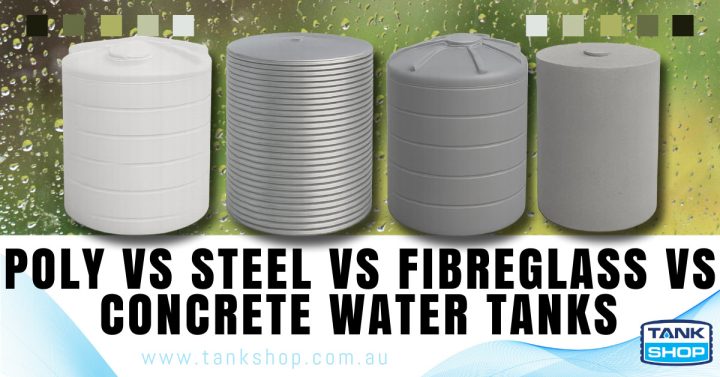Water Tank Buying Guide
Poly vs Steel vs Fibreglass vs Concrete Water Tanks
Rainwater tanks can be made and delivered in a range of material substances including polyethylene plastic (poly), a range of steels, precast concrete and fibreglass reinforced plastic. When comparing tank materials, it isn’t necessarily a case of which is best, but rather which is more suitable to your situation and budget. Read on to receive a rundown of each tank material type.
Poly Water Tanks
Poly tanks are one of the most popular substances today. There are good reasons for this:
- Poly tanks are normally lower in price than all other tanks.
- Poly tanks can be found in sizes up to 50,000 litres, though for their price it can be more cost-effective installing multiple poly tanks rather than one very large steel tank.
- Poly tanks made to Australian standards (AS/NZS 4766) are strong and durable.
- Polyethylene used is normally food-grade (AS/NZ 2070) and safe for drinking (AS/NZS 4020) – in Australia most manufacturers source their polyethylene from the same suppliers.
- Poly is a flexible plastic allowing a diverse range of tank types and styles such as round, tall, squat, slimline, underground, under deck, ribbed, flat and tapered.
- Poly tanks are relatively easy to load, deliver, unload and move into place.
- Poly tanks exist in a wide range of COLORBOND®
- Poly tanks won’t rust, corrode or taint your water.
Steel Water Tanks
There exists quite a range of steel tanks on the market including galvanised steel, stainless steel and modern steels such as BlueScope’s ZINCALUME® and AQUAPLATE® (which is basically ZINCALUME with a COLORBOND coating).
Galvanised steel is what traditional water tanks in the outback were made from. They are comprised of iron steel sheets coated in zinc. The zinc coating is what protects the steel against rust and corrosion, and higher grade galvanised steels have thicker coatings. For example, a zinc coating of 450g/m2 results in galvanised steel three times as resistant to weathering than 150g/m2.
Stainless steel is normally considered to be the highest quality tank material and as such normally yields more expensive water tanks. They can be generally found in two different grades: 1) Grade 304 Stainless Steel which is the same as kitchen sinks, and 2) Marine Grade 316 Stainless Steel which can withstand harsh marine environments.What makes the steel “stainless” is the amount of chromium present and how uniformly it is mixed into the steel.
With stainless steel tanks, the important area is how they are joined together with rivets or screws. Ideally, stainless steel manufacturers should use similar quality steel for joining,. This hasn’t always been the case however, some companies even using lead which resulted in a negative impact upon health (read Stainless Steel Rainwater Tanks and Lead: Questions and Answers).
ZINCALUME and AQUAPLATE (a COLORBOND steel) are more modern fabricated steels. Two generations of ZINCALUME steel exist – Next Generation (AM125) which came out in August 2013 and lasts significantly longer than the Previous Generation (AZ150). ZINCALUME is normally used for roofing, however some companies also manufacture water tanks from it.
AQUAPLATE is ZINCALUME® steel (AZ150) hot-dipped in zinc. Marketed for rainwater tank use, it has a thin inner poly lining to protect against water, and normally a COLORBOND colour on the outside.
With steel it is important to match them according to compatible metals. For example, modern ZINCALUME and AQUAPLATE steels are incompatible with copper and lead. If you have ZINCALUME rooftops, flashings, gutters or pipework then you don’t want to get a galvanised tank or vice-versa.
Steel tanks are manufactured in similar sizes to poly tanks which are appropriate for home owners. Large steel panel tanks can be found in capacities up to 250,000 to 400,000 litres depending upon the manufacturer and steel used. This makes them good for rural areas, agriculture and even councils. Some companies will also provide custom solutions to meet very particular needs.
Warranty conditions attached to steel tanks should be carefully read as they are normally quite detailed with what will void your warranty. For example, modern steels can’t touch treated timber, fertilisers, pesticides, leaves and vegetation or dissimilar metals. Stainless steel is much more resilient though, although it too should still be kept clean of debris, especially chlorine and iron.
Based upon a 10,000L round tank, the cost of Aquaplate Steel is around $2400, 304 stainless steel costing from $2200-$2800 depending on the dimensions. Marine-grade 316 stainless steel costs around 20% more than 304, ranging between $2700-$3700 depending on the dimensions. Steel tanks are a bit more expensive than a poly tank, the same 10,000L size poly tank costing around $1700. As the size increases though, the price difference becomes more significant.
Fibreglass Water Tanks
Fibreglass is a common type of fibre-reinforced plastic using glass fibre. Fibres may be randomly arranged, flattened into a sheet, or woven into a fabric. The composite is often called “fibreglass reinforced plastic.”
Fibreglass is very stiff and rigid with a high tensile strength. Glass is one of the strongest textile fibres, possessing a higher tensile strength than steel wire. It won’t stretch and warp, making is a good material for mouldings and prototypes.
Tooling costs involved are lower with fibreglass which makes it suitable for once-off projects or complex designs and shapes often required in aquaculture and aquaponics. The quality of a fibreglass tank depends on its maker, so you should spend time comparing companies and asking questions, especially for larger projects.
When it comes to storing rainwater, the thinness and lightness can make them brittle and prone to cracking. Without applying an additional layer or higher-level composites, fibreglass will allow light entry which causes algae growth. Food-grade coatings are also needed to be up to Australian Standards for storing potable water.
All this adds greater expense, and unless you have very particular needs, generally it more simple and cheaper to purchase a tank in a different material.
Pre-Cast Concrete Water Tanks
Concrete is very strong, the strength of which depends upon the actual mixture and setting process. It is comprised of cement mixed with water, which behaves as the binding agent to sands, gravel and crushed stone. Steel mesh is often laid into the concrete mixed before being poured, which provides greater structural integrity once set.
Due to its strength and how ease of pouring, concrete is used in buildings, swimming pools, driveways, walkways, dams and many other structures. The difference with a pre-cast concrete water tank is that it is pre-made to be delivered. Tanks made from concrete are normally quite strong and can last a long time if properly reinforced with steel.
Pre-cast concrete tanks can be delivered fully formed in sizes up to around 30,000 litres. They are extremely heavy – a 10,000 litre tank weighs around 7,000 kg. As such, they need to be delivered by a crane truck. If access to your property is difficult, then they may not be a suitable option.
Unlike steel tanks, there is no concern with concrete corroding when in contact with different soils and moisture. Nonetheless, concrete is prone to cracking and breaking over time. This can caused in areas where there is ground movement, or very hot and cold/wet and dry extremes.
If you will be drinking or cooking with your tank water, then a properly maintained concrete tank is safe. Lime in concrete will leak into the water, however this actually reduces the acidity of rainwater making it safer to drink. The reason for this is because copper pipes are used in plumbing. Highly acidic water left in the pipes will cause copper to leach into it. For this reason it is recommended with other tanks that you let in-home taps run for a minute before using for consumption.
Finally, the price of tanks made from pre-cast concrete are the most expensive. Based upon a 10,000 litre water tank, a pre-cast concrete tank would set you back around $4,000.
This article has hopefully provided you with a good summary of different tank materials available and which is most suitable for your needs. If you’ve found this article helpful, please comment below and/or share it with family and friends. I’m also happy to answer follow-up questions.




Great reading, poly for me then safe drinking…. Though I grew up on zinc and gal, healthy
Very good advice
Great reading! Im located in Brisbane on 5 acres and trying to decide between steel and in ground concrete. It’s so hard!
Informative article, thanks. Lots of options, though I’ll never trust plastic.